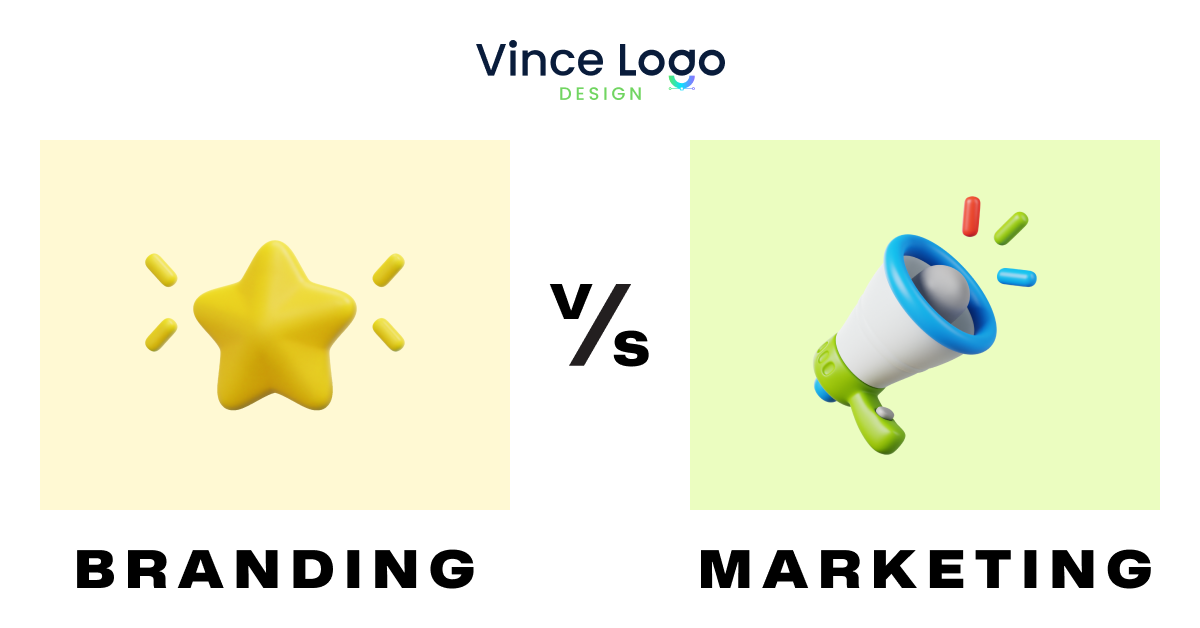
In today’s competitive and challenging business landscape, “branding” and “marketing” are often used simultaneously, often leading to confusion about their distinct roles in a company’s success.
While both are integral to building a strong presence in the market, understanding the difference between branding and marketing is crucial for crafting strategies that resonate with your audience and propel growth.
Branding is the essence of who you are as a company—the identity, values, and promise you communicate to the world. Conversely, marketing is the tactical approach to promote and sell that brand, engaging potential customers and converting them into loyal advocates.
Together, they form the foundation of a successful business, yet their functions and impacts are uniquely different. In this exploration of branding versus marketing, we’ll explore what sets them apart and how they work harmoniously to create lasting impressions and drive business success.
Defining Branding–What is Branding?

Branding is all about establishing a remarkable identity for a company or a product. It involves designing a logo, tagline, name, brand identity, equity, position, awareness, visibility, and value. The comprehensive goal of branding is to create a positive perception of a brand to build the brand name and boost sales.
Types of Branding
Branding goes beyond building a personal image to crafting a corporate identity. Branding encompasses various forms, including:
- Umbrella Branding
- Personal Branding
- Retail Branding
- Corporate Branding
- E-commerce Branding
- Service Branding
- Co-Branding
- Audio Branding
Elements of Branding

Branding confines all business activities devoted to defining a company’s existence. Elements of branding are listed below:
- Brand Name
- Brand Value
- Brand Equity
- Brand Position
- Brand Collateral
- Brand Identity
- Brand Purpose
- Brand Loyalty
- Brand Photography
- Brand Logo
- Brand Colors
- Brand Typeface
- Brand Mission
Principals of Branding
- Authenticity: Portraying true brand identity and values to foster trust with the audience.
- Coherence: Ensuring all aspects of branding are working conjointly and harmoniously to display a cohesive and straightforward message.
- Differentiation: Distinguish yourself from your competitors and chant what makes you different.
- Sustainability: Evaluate the long-term impact of branding on your society and environment.
Role of Branding

Branding is the strategy of shaping and creating a palpable identity for a company or brand. Establishing strong branding cultivates consumer recognition, trust, and loyalty. A well-defined and goal-oriented brand distinguishes its products from its competitors, positions it higher in the market, and influences buyers’ decisions.
Organizations must consistently deliver brand promises, create authentic customer experiences, and incorporate targeted strategies to resonate with the desired audience.
Example of Successful Branding
Apple is an excellent example of branding as it excels in branding. Apple’s logo is instantly recognizable, and the products are known for cutting-edge technology, sleek design, and high quality. Apple’s branding is more than just a logo design or product; the company is also known for outstanding customer service and communication skills.
Define Marketing–What is Marketing?

Marketing is the tool, medium, and tactic for communicating a brand’s identity and message. It helps drive customer interest, engagement, and sales. Marketing campaigns change simultaneously based on a wide range of parameters, including economy, trends, competitors, sentiments, and season.
Marketing strategies target different audience segments while reinforcing and reflecting the core brand values. They are a vast umbrella that incorporates several tactics and tools depending on the targeted audience. They can be a combination of content, including text, keywords, images, videos, and memes.
Types of Marketing
Marketing is the business approach to determining customers’ needs and desires. It incorporates this Information to design strategies for marketing targeted products and services and selling them effectively.
- SEO/SEM
- Event Marketing
- Influencer Marketing
- Social Media Marketing
- Mobile Marketing
- Email Marketing
- Native Advertising
- Content Marketing
- Radio
- OOH (Out-of-Home) Advertising
- Print Campaigns
- TV/CTV
Elements of Marketing

The rudimentary elements of marketing are often referred to as the marketing mix. Traditionally, it consisted of the four Ps:
- Product: The service or good being offered/sold. It includes the features, benefits, packaging, and the brand name.
- Price: The allotted payment for the product or good. It involves discounts, equity, allowance, price strategy, coupon payment methods, and terms.
- Place: How the product reaches the customer. This includes distribution channels, logistics, inventory management, and market coverage.
- Promotion: Communicating the product’s value to the target market. This encompasses advertising, public relations, sales promotions, personal selling, and digital marketing.
- People: The human element involved in the delivery of the product or service.
- Process: The systems and procedures in place to deliver the product or service.
- Packaging: The container or wrapping of the product.
Principals Of Marketing
- Positioning: Determine and communicate the brand’s value proposition to the audience.
- Customer focus: Employ marketing efforts that meet the needs and preferences of the audience.
- Testing and optimization: Frequently testing and modifying marketing strategies to enhance results.
- Integration: Ensure all marketing efforts work jointly to devise a cohesive and effective campaign.
Role Of Marketing

Marketing shapes brand identity and drives sales by creating awareness, fostering loyalty, and positioning products effectively. Strategic marketing amplifies brand visibility and boosts sales.
Example of Marketing
Coca-Cola excels in marketing, and its share of a Coke campaign is evidence of its success. The campaign prompted a lot of buzz on social media and helped drive sales. Coca-Cola’s marketing strategy is focused on creating emotional affinities with its customers, which has helped make the brand a household name.
What is the Difference Between Branding and Marketing
Differences between branding and marketing are highlighted in the table below:
| Branding | Marketing |
| Long Term | Short Term |
| The procedure of creating a unique identity | The procedure of promoting a unique identity |
| Focuses on developing a positive image and reputation | Focus on driving sales and generating leads. |
| Fosters emotional connection | Provides Information |
| Consistent across all platforms | Altered across all platforms |
| Enhance brand equity and recognition | Enhance lead conversion and ROI |
| Remains Consistent | Constantly Evolving |
| Create Reputation | Create Sales |
The Symbiotic Relationship Between Branding and Marketing
Branding Influences Marketing
A strong brand is a roadmap of marketing efforts that ensures consistency in message, tone, and visuals. It determines the audience and maximizes the impact of marketing.
Marketing Supports Branding
Effective marketing amplifies a brand’s story, awareness, and loyalty. Marketing reinforces brand values by delivering on brand promises through campaigns and experiences.
Case Study: Brand and Marketing in Harmony
Coca-Cola’s iconic brand identity is consistently reflected in its marketing campaigns. The brand’s focus on happiness and togetherness is integrated into its advertising, creating a strong connection and driving sales.
Conclusion
Understanding what is branding and marketing is essential for any business aiming for long-term success. Branding defines your identity, while marketing drives engagement. Both are crucial and work hand-in-hand. Evaluate your strategies to ensure they align and support each other for maximum impact.
Ready to elevate your brand and marketing efforts? With Vince, experience Effortless branding!
Explore More:

Vince Logo Design is a distinguished digital marketing agency, specializing in crafting compelling brand identities and optimizing online presence. We are your partners in creating impactful digital strategies that drive results.
Get in touch.Articles
- Top 10 SEO Benefits of Responsive Web Design in 2025
- 8 Best CMS for Small Business in 2025: Pick the Popular
- 5 Best Hosting for Small Business Websites
- Affordable WordPress Website Design: Best Service Provider
- Custom Design Vs Template Website: Which One Is Best?
- Fix My WordPress Site: WSOD, Redirect & Site Maintenance
Get Free Consultancy
Fill the following form and receive a guaranteed response within 48 hours.
We have worked with world's leading brands











